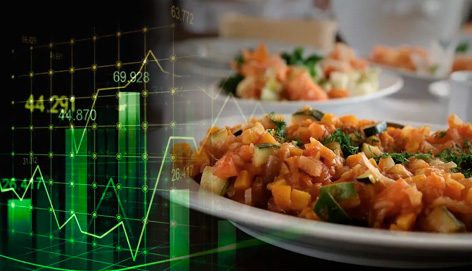ANALYSIS OF THE FEASIBILITY OF IMPLEMENTING AN INDICATOR OF FOOD WASTE AND LEFTOVERS IN THE ELABORATION OF FAB MENUS
DOI:
https://doi.org/10.22480/revunifa.2023.36.454Keywords:
Waste, Menus, Indicators, Performance, RestaurantsAbstract
The presence of organic leftovers and food waste in distribution and consumption is recurring, even in the most varied types of restaurants. In public agencies, this issue becomes relevant for the manager when considering all stages of the production chain until decision making. Following good global practices, the acceptable limit for leftovers is set at up to 10%, so that the impacts and costs involved are reduced. For the preparation of menus in the Brazilian Air Force, FCA 145-16/2018 is used, which lists the minimum quantities for meals. However, there is a lack of an indicator relating to the levels of leftovers and waste, thus resulting in a lack of management results in this aspect. Given the above, this work aims to verify the feasibility of implementing a new indicator so that waste is evaluated and estimated in its quantity and helps in the management of production and resources. To achieve this objective, the proposed methodology will be bibliographical research about the leftovers and the respective indicators along with a case study in the Air Force Academy ranch. It is expected that the results may add to the efficiency of management in the Brazilian Air Force's Subsistence Units.
References
ABREU, E. S., et al. Gestão de unidades de alimentação e nutrição: um modo de fazer. São Paulo: Metha, 4 ed. 2013.
ARAUJO, A. O. Contribuição ao Estudo de Indicadores de Desempenho de Empreendimentos Hoteleiros, sob o Enfoque da Gestão Estratégica. USP, 2001. Disponível em: <https://www.teses.usp.br/teses/disponiveis/12/12136/tde-01032002-115642/publico/tde.pdf>. Acesso em: 1 jun. 2021.
BARBOSA, M. S. F. Política de adaptação de cardápios às necessidades dos comensais: uma ferramenta eficiente para a redução do desperdício no Serviço de Subsistência do GAP-YS. Rio de Janeiro: Escola de Aperfeiçoamento de Oficiais da Aeronáutica, 2020. Monografia. (14 p.). Disponível em: <https://redebia.direns.aer.mil.br/index.asp?codigo_sophia=78549>. Acesso em: 1 jun. 2021.
BRASIL. Comando da Aeronáutica. FCA 145-16: Elaboração de cardápios e indicadores de subsistência. Brasília, 2018.
_______. Lei nº 6.880, 9 de dezembro de 1980. Dispõe sobre o Estatuto dos Militares. Disponível em: <http://www.planalto.gov.br/CCIVIL_03/LEIS/l688ocompilada.htm>. Acesso em: 28 mai. 2021.
_______. Lei nº 14.016, 23 de junho de 2020. Dispõe sobre o combate ao desperdício de alimentos e a doação de excedentes de alimentos para o consumo humano. Disponível em: <http://www.planalto.gov.br/ccivil_03/_ato2019-2022/2020/lei/L14016.htm>. Acesso em: 03 jun. 2022.
CARO, M. H.; RADOS, G. J. V.; NERES, W. A. Estruturando a medição do desempenho organizacional. ABEPRO, 1998. Disponível em: <http://www.abepro.org.br/biblioteca/ENEGEP1998_ART517.pdf>. Acesso em: 30 maio. 2021.
CASTRO, F. A. F.; QUEIROZ, V. M. V. Cardápios: planejamento, elaboração e etiqueta. Universidade Federal de Viçosa, 1998. p. 1-29.
FAO. O desperdício alimentar tem consequências ao nível do clima, da água, da terra e da biodiversidade: – novo estudo da FAO. FAO. Roma, 2013. Disponível em: <https://observatorio3setor.org.br/noticias/brasil-desperdica-26-milhoes-de-toneladas-de-alimentos-por-ano/>. Acesso em: 26 mai. 2021.
FERIGOLLO, M. C.; BUSATO, M. A. Desperdício de alimentos em unidades de alimentação e nutrição: uma revisão integrativa da literatura. HOLOS, 2018. Disponível em: <https://www2.ifrn.edu.br/ojs/index.php/HOLOS/article/view/4081/pdf>. Acesso em 03 jun. 2022.
FNQ. Indicadores de Desempenho – Estruturação do Sistema de Indicadores Organizacionais. 3. ed. São Paulo: Fundação Nacional da Qualidade, 2012.
GARCIA. M. F. Brasil desperdiça 26,3 milhões de toneladas de alimentos por ano. Observatório do Terceiro Setor, 2019. Disponível em: <https://observatorio3setor.org.br/noticias/brasil-desperdica-26-milhoes-de-toneladas-de-alimentos-por-ano/>. Acesso em: 27 mai. 2021
GIL, A. C. Como elaborar projetos de pesquisa. 6. Ed. São Paulo: Atlas, 2017.
________. Como Elaborar Projetos de Pesquisa. 6. ed. São Paulo: Atlas, 2019.
HIRSCHBRUCH, M. D. Unidades de Alimentação e Nutrição: desperdício de alimentos X qualidade da produção. Revista Higiene Alimentar, v. 12, n. 55, p. 12-14, 1998
PARISOTO; HAUTRIVE; CEMBRAEL. Redução do desperdício de alimentos em um restaurante popular. Revista Brasileira de Tecnologia Agroindustrial. 2013. Disponível em: <https://www.unochapeco.edu.br/static/data/portal/downloads/2729.pdf>. Acesso em: 28 mai. 2021
RABELLO, N. M. L.; ALVES, T. C. U. Avaliação do percentual de resto-ingestão e sobra alimentar em uma unidade de alimentação e nutrição institucional. Revista Brasileira de Tecnologia Agroindustrial, 2016. Disponível em:<https://periodicos.utfpr.edu.br/rbta/article/viewFile/1808/3136#:~:text=O%20desperd%C3%ADcio%20nas%20UANs%20est%C3%A1,devendo%20ficar%20sob%20refrigera%C3%A7%C3%A3o%20e>. Acesso em: 1 jun. 2021
TAGUCHI, V. Comida no lixo. UOL, 2021. Disponível em: <https://economia.uol.com.br/reportagens-especiais/agronegocio-desperdicio-de-alimentos/#cover>. Acesso em 19 jul. 2022.
TAKASHINA, N. T.; FLORES, Mario C. X. Indicadores da qualidade e do desempenho: como estabelecer metas e medir resultados. Rio de Janeiro: Qualitymark, 2005.
UCHOA, C. E.; Elaboração de indicadores de desempenho institucional. Desenho e elaboração Coordenação Geral de Programas de Capacitação /DDG. Brasília: ENAP/DDG, 2013. 36p
UNEP. ONU: 17% de todos os alimentos disponíveis para consumo são desperdiçados. UNEP. Nairobi/Paris, 2021. Disponível em: < https://www.unep.org/pt-br/noticias-e-reportagens/comunicado-de-imprensa/onu-17-de-todos-os-alimentos-disponiveis-para-consumo>. Acesso em: 26 mai. 2021.
VALERY, G. Insegurança alimentar voltou a crescer, e fome atinge 19,1 milhões. Rede Brasil atual, 2021. Disponível em: <https://www.redebrasilatual.com.br/cidadania/2021/10/fome-brasil-19-milhoes-inseguranca-alimentar/>. Acesso em: 03 jun. 2022.
VILLAN, K. M.; ALVES, F. S. Desperdício de alimentos em uma Unidade de Alimentação e Nutrição: análise e propostas. NUTRIÇÃO BRASIL, 2010. Disponível em:<https://www.researchgate.net/profile/Livia-Tonucci/publication/260553166_Importancia_do_alho_Allium_sativum_L_na_saude_humana/links/00b7d5318abd874f09000000/Importancia-do-alho-Allium-sativum-L-na-saude-humana.pdf#page=5>. Acesso em: 03 jun. 2022.
VAZ, C. S. Restaurantes – Controlando custos e aumentando lucros. Brasília, Ed. LGE, 2006, 196 p.

Downloads
Published
Issue
Section
License
Copyright (c) 2023 Matheus Costa Felippini , Luiz Gustavo Antonio de Souza, Osmar Gonçalves

This work is licensed under a Creative Commons Attribution-NonCommercial 4.0 International License.
Revista da UNIFA permite que o (s) autor (es) mantenha(m) seus direitos autorais sem restrições. Atribuição-NãoComercial 4.0 Internacional (CC BY-NC 4.0) - Revista da UNIFA é regida pela licença CC-BY-NC








